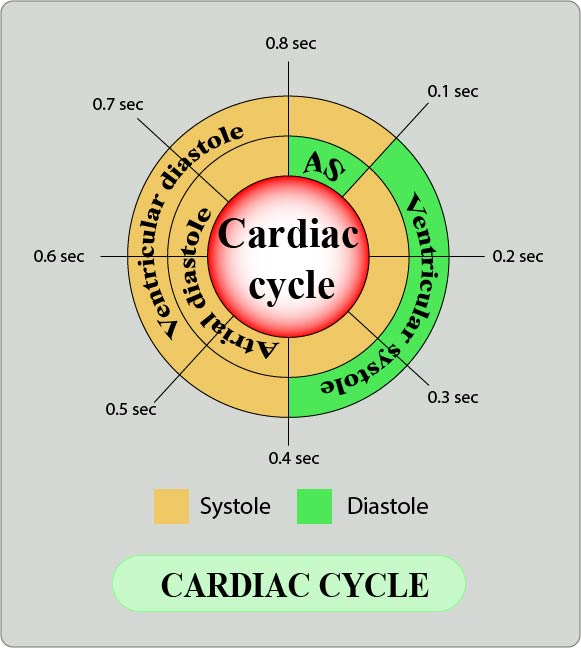
The duration of cardiac cycle is
(a) 0.8 sec
(b) 0.8 sec
(c) 0.08 sec
(d) 0.008 sec
Answer
506.4k+ views
Hint: Sequence of alternating contraction and relaxation of the atria and ventricles in order to pump blood throughout the body is called a cardiac cycle. It starts at the beginning of one heartbeat and ends at the beginning of another.
Complete answer:
diastole, is the reciprocal of the heart rate. It consists of a period of relaxation called diastole, during which the heart fills with blood, followed by a period of contraction called systole. For e.g. If heart rate is 72 beats/min, the duration of the cardiac cycle is 1/72 beats/min about 0.0139 minutes per beat, or 0.833 seconds per beat.
Additional information:
SA node or the pacemaker has the property of automaticity and rhythmicity. Due to this it produces action potentials, which spread all along the atrial and ventricular muscle fibers. This ultimately brings about depolarization and repolarization. These various changes occur in the heart, which is repeated from beat to beat. These events are known as events of cardiac cycle.
So, the correct answer is 0.8 sec.

Note:
- Each cardiac cycle has a diastolic phase where the heart chamber is in state of relaxation and fills with blood that receives from the veins and a systolic phase where the heart chambers contracts and pumps the blood towards the periphery via the arteries.
- Both the atria and the ventricles undergo alternating states of systole and diastole.i.e.when the atria are in diastole, the ventricles are in systole and vice versa.
Complete answer:
diastole, is the reciprocal of the heart rate. It consists of a period of relaxation called diastole, during which the heart fills with blood, followed by a period of contraction called systole. For e.g. If heart rate is 72 beats/min, the duration of the cardiac cycle is 1/72 beats/min about 0.0139 minutes per beat, or 0.833 seconds per beat.
Additional information:
SA node or the pacemaker has the property of automaticity and rhythmicity. Due to this it produces action potentials, which spread all along the atrial and ventricular muscle fibers. This ultimately brings about depolarization and repolarization. These various changes occur in the heart, which is repeated from beat to beat. These events are known as events of cardiac cycle.
So, the correct answer is 0.8 sec.

Note:
- Each cardiac cycle has a diastolic phase where the heart chamber is in state of relaxation and fills with blood that receives from the veins and a systolic phase where the heart chambers contracts and pumps the blood towards the periphery via the arteries.
- Both the atria and the ventricles undergo alternating states of systole and diastole.i.e.when the atria are in diastole, the ventricles are in systole and vice versa.
Recently Updated Pages
Master Class 11 Business Studies: Engaging Questions & Answers for Success

Master Class 11 Accountancy: Engaging Questions & Answers for Success

Master Class 11 Computer Science: Engaging Questions & Answers for Success

Master Class 11 English: Engaging Questions & Answers for Success

Master Class 11 Social Science: Engaging Questions & Answers for Success

Master Class 11 Economics: Engaging Questions & Answers for Success

Trending doubts
Which one is a true fish A Jellyfish B Starfish C Dogfish class 11 biology CBSE

State and prove Bernoullis theorem class 11 physics CBSE

1 ton equals to A 100 kg B 1000 kg C 10 kg D 10000 class 11 physics CBSE

In which part of the body the blood is purified oxygenation class 11 biology CBSE

One Metric ton is equal to kg A 10000 B 1000 C 100 class 11 physics CBSE

Difference Between Prokaryotic Cells and Eukaryotic Cells




